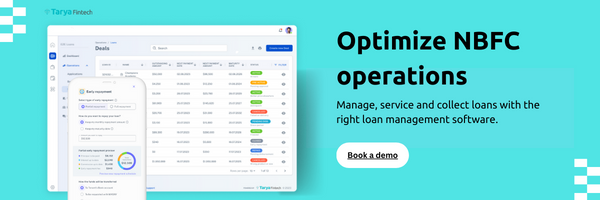In today’s fast-paced financial world, loan management software has become a crucial tool for financial institutions. Whether you are a Non-Banking Financial Company (NBFC), a lender, or a business looking to implement lending technology, understanding the fundamentals of loan management software is essential. This article aims to explore the basics, types, features, and costs associated with loan management software.
Loan Management Solutions
Loan management solutions play a pivotal role in streamlining the loan origination and servicing processes. These software systems automate various tasks, enabling efficient management of loans. The key objective of loan management solutions is to simplify complex lending operations and enhance overall productivity. Let’s delve into the essential aspects of loan management software:
Loan Management Software
Loan management software serves as the backbone of loan operations for NBFCs, lenders, and other financial institutions. It provides a centralized platform to manage the entire loan lifecycle, from application processing to disbursal and collections. The software offers a comprehensive suite of features to ensure seamless administration and tracking of loans. Let’s explore some of the notable features commonly found in loan management software:
Loan Management Features
1. Loan Origination:
The loan origination process involves assessing the borrower’s creditworthiness, verifying documents, evaluating risk, and determining the loan amount. Loan management software streamlines this process by automating credit checks, document management, and risk assessment. It expedites the approval process and reduces manual errors, leading to faster loan disbursals.
2. Loan Servicing:
Loan servicing encompasses the activities involved in post-disbursal loan management, including tracking repayments, generating statements, managing penalties, and handling collections. Loan management software facilitates accurate repayment tracking, automates statement generation, and enables seamless communication with borrowers, ensuring timely collection of loan installments.
3. Workflow Automation:
Efficient workflow automation is a critical feature of loan management software. It allows users to configure and automate various stages of the loan process, reducing manual effort and enhancing operational efficiency. Workflow automation ensures that loan applications follow a predefined path, with appropriate approvals, verifications, and disbursements, minimizing the need for manual intervention.
4. Risk Assessment and Compliance:
Loan management software incorporates robust risk assessment and compliance modules. It leverages data analytics and credit score analysis to evaluate the creditworthiness of borrowers, reducing the risk of defaults and delinquencies. Additionally, it ensures adherence to regulatory requirements and compliance with applicable laws, safeguarding the interests of both lenders and borrowers.
5. Reporting and Analytics:
Comprehensive reporting and analytics capabilities are vital for financial institutions to monitor loan portfolios and assess performance. Loan management software offers customizable dashboards, real-time analytics, and detailed reports to aid decision-making. It provides insights into loan disbursements, collections, delinquencies, and overall portfolio health, enabling lenders to optimize their lending strategies.

Types of Loan Management Software
Loan management software comes in various types, catering to the diverse needs of financial institutions. Understanding the different types can help choose the most suitable solution for your specific requirements. Let’s explore the most common types of loan management software:
1. On-Premises Loan Management Software:
On-premises loan management software is installed and operated on the organization’s own servers or infrastructure. It offers full control over data and customization options while ensuring data security. However, it requires substantial upfront investment, ongoing maintenance, and dedicated IT resources to manage and update the software.
2. Cloud-Based Loan Management Software:
Cloud-based loan management software, also known as Software-as-a-Service (SaaS), is hosted on remote servers and accessed through the internet. It offers flexibility, scalability, and ease of deployment as there is no requirement for on-premises infrastructure. Cloud-based solutions provide regular updates, data backups, and enhanced security measures, ensuring that NBFCs and lenders can focus on their core operations.
3. Open-Source Loan Management Software:
Open-source loan management software is a cost-effective option that allows organizations to customize and modify the software’s source code to suit their specific needs. It offers flexibility and the ability to integrate with existing systems. However, technical expertise is required to set up, maintain, and troubleshoot the software.
4. Vendor-Provided Loan Management Software:
Vendor-provided loan management software is developed and sold by technology vendors specializing in lending solutions. These software solutions are typically feature-rich, user-friendly, and cater to the specific requirements of NBFCs and lenders. Vendor-provided solutions offer professional support, regular updates, and seamless integration with other financial systems.
Cost Considerations
The cost of loan management software varies based on factors such as the type of software, organization size, required functionality, and vendor pricing structure. On-premises software generally involves upfront costs for licenses, implementation, infrastructure, and ongoing maintenance. Cloud-based solutions typically follow a subscription-based pricing model, charging monthly or annual fees based on usage and user count. Open-source software may have lower upfront costs but requires technical expertise for customization and maintenance. Vendor-provided solutions vary in pricing based on features, support, and scalability options.
Conclusion
Loan management software plays a crucial role in the efficient administration of loans for NBFCs, lenders, and financial institutions. Understanding the fundamentals, types, features, and costs associated with loan management software is essential for businesses venturing into the financial sector or aiming to implement lending technology. By leveraging the right loan management software and its comprehensive features, organizations can streamline loan operations, enhance productivity, mitigate risk, and drive business growth in today’s competitive lending landscape.
About Tarya Fintech’s Solutions
Tarya Fintech offers software solutions and loan platform products designed to provide highly robust functionality, ensuring full compliance with accordance to RBI’s new requirements and the 2023 Digital Personal Data Protection Act. Our platforms support the end-to-end loan processes required of a CFSS, offering an efficient, user-friendly, secure, and scalable system. Through Tarya Fintech, NBFCs have the power to transform their lending and business operations and achieve enhanced profitability.




